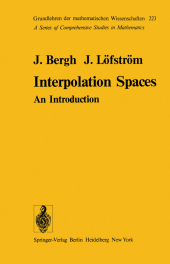 Neuerscheinungen 2011Stand: 2020-01-07 |
Schnellsuche
ISBN/Stichwort/Autor
|
Herderstraße 10
10625 Berlin
Tel.: 030 315 714 16
Fax 030 315 714 14
info@buchspektrum.de |

J. Bergh, Jorgen Löfström
(Beteiligte)
Interpolation Spaces
An Introduction
Softcover reprint of the original 1st ed. 1976. 2011. x, 207 S. 5 figs. X,207 pages. 244 mm
Verlag/Jahr: SPRINGER, BERLIN 2011
ISBN: 3-642-66453-9 (3642664539)
Neue ISBN: 978-3-642-66453-3 (9783642664533)
Preis und Lieferzeit: Bitte klicken
The works of Jaak Peetre constitute the main body of this treatise. Important contributors are also J. L. Lions and A. P. Calderon, not to mention several others. We, the present authors, have thus merely compiled and explained the works of others (with the exception of a few minor contributions of our own). Let us mention the origin of this treatise. A couple of years ago, J. Peetre suggested to the second author, J. Lofstrom, writing a book on interpolation theory and he most generously put at Lofstrom´s disposal an unfinished manu script, covering parts of Chapter 1-3 and 5 of this book. Subsequently, LOfstrom prepared a first rough, but relatively complete manuscript of lecture notes. This was then partly rewritten and thouroughly revised by the first author, J. Bergh, who also prepared the notes and comment and most of the exercises. Throughout the work, we have had the good fortune of enjoying Jaak Peetre´s kind patronage and invaluable counsel. We want to express our deep gratitude to him. Thanks are also due to our colleagues for their support and help. Finally, we are sincerely grateful to Boe1 Engebrand, Lena Mattsson and Birgit Hoglund for their expert typing of our manuscript.
1. Some Classical Theorems.- 1.1. The Riesz-Thorin Theorem.- 1.2. Applications of the Riesz-Thorin Theorem.- 1.3. The Marcinkiewicz Theorem.- 1.4. An Application of the Marcinkiewicz Theorem.- 1.5. Two Classical Approximation Results.- 1.6. Exercises.- 1.7. Notes and Comment.- 2. General Properties of Interpolation Spaces.- 2.1. Categories and Functors.- 2.2. Normed Vector Spaces.- 2.3. Couples of Spaces.- 2.4. Definition of Interpolation Spaces.- 2.5. The Aronszajn-Gagliardo Theorem.- 2.6. A Necessary Condition for Interpolation.- 2.7. A Duality Theorem.- 2.8. Exercises.- 2.9. Notes and Comment.- 3. The Real Interpolation Method.- 3.1. The K-Method.- 3.2. The J-Method.- 3.3. The Equivalence Theorem.- 3.4. Simple Properties of ??, q.- 3.5. The Reiteration Theorem.- 3.6. A Formula for the K-Functional.- 3.7. The Duality Theorem.- 3.8. A Compactness Theorem.- 3.9. An Extremal Property of the Real Method.- 3.10. Quasi-Normed Abelian Groups.- 3.11. The Real Interpolation Method for Quasi-Normed Abelian Groups.- 3.12. Some Other Equivalent Real Interpolation Methods.- 3.13. Exercises.- 3.14. Notes and Comment.- 4. The Complex Interpolation Method.- 4.1. Definition of the Complex Method.- 4.2. Simple Properties of ?[?].- 4.3. The Equivalence Theorem.- 4.4. Multilinear Interpolation.- 4.5. The Duality Theorem.- 4.6. The Reiteration Theorem.- 4.7. On the Connection with the Real Method.- 4.8. Exercises.- 4.9. Notes and Comment.- 5. Interpolation of Lp-Spaces.- 5.1. Interpolation of Lp-Spaces: the Complex Method.- 5.2. Interpolation of Lp-Spaces: the Real Method.- 5.3. Interpolation of Lorentz Spaces.- 5.4. Interpolation of Lp-Spaces with Change of Measure: p0 = p1.- 5.5. Interpolation of Lp-Spaces with Change of Measure: p0 ? p1.- 5.6. Interpolation of Lp-Spaces of Vector-Valued Sequences.- 5.7. Exercises.- 5.8. Notes and Comment.- 6. Interpolation of Sobolev and Besov Spaces.- 6.1. Fourier Multipliers.- 6.2. Definition of the Sobolev and Besov Spaces.- 6.3. The Homogeneous Sobolev and Besov Spaces.- 6.4. Interpolation of Sobolev and Besov Spaces.- 6.5. An Embedding Theorem.- 6.6. A Trace Theorem.- 6.7. Interpolation of Semi-Groups of Operators.- 6.8. Exercises.- 6.9. Notes and Comment.- 7. Applications to Approximation Theory.- 7.1. Approximation Spaces.- 7.2. Approximation of Functions.- 7.3. Approximation of Operators.- 7.4. Approximation by Difference Operators.- 7.5. Exercises.- 7.6. Notes and Comment.- References.- List of Symbols.


